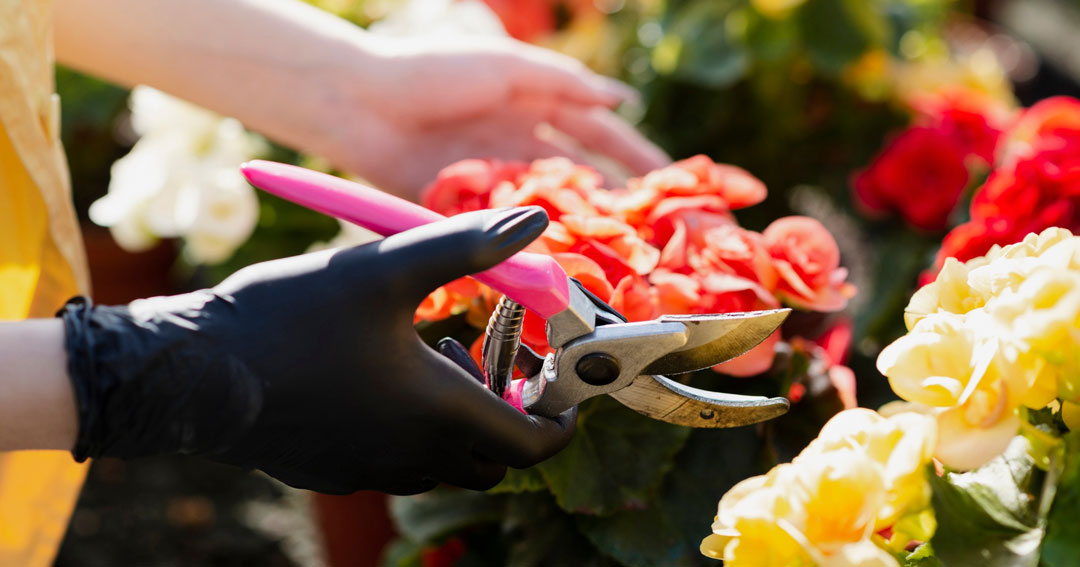A garden is more than a collection of plants. It's a magical realm, a tiny ecosystem that thrives under your care. And as any seasoned gardener would confirm, the difference between a garden that wilts and a garden that blooms spectacularly lies in the resources you use.
Knock Out roses are celebrated for their resilience and beauty, becoming a staple in gardens for their ability to flourish with minimal fuss. Recognized for their robust nature, these flowering shrubs require no black spot spraying and have opened up a world of easy-care roses for southern gardeners. With gardening enthusiasts often asking, "When should I prune my knockout roses?" and "How do you keep knock out roses looking good?", it's clear that understanding the best practices for pruning is essential for maintaining their vibrant display.
The key to ensuring Knock Out roses' health and aesthetic appeal lies in timely pruning, recommended in late winter to early spring to preserve the season's bloom. This period, particularly in mid-March for Zone 7, New Jersey, is identified as the ideal time to prune, aligning with the emergence of new shoots on the rose bush. Pruning not only keeps these roses in their desired shape and size but also significantly contributes to their vitality and bloom quality, a task that gardening enthusiasts approach with queries like "When and how to cut a rose?" and "When and how should I prune my roses?”.
Understanding Knock Out Roses
Understanding Knock Out Roses begins with recognizing their introduction to the gardening world over 20 years ago, marking a revolution in rose cultivation with their resilience and ease of care. These roses have expanded beyond the original variety to include a vibrant palette of ten additional colors and flower forms, catering to diverse gardening aesthetics. Notably, their flowering prowess is unmatched, blooming more frequently and for longer durations than hydrangeas and other traditional flowers, making them a standout choice for gardeners seeking continuous color.
Varieties: The Knock Out® Family of Roses boasts an array of types including the Blushing Knock Out®, Coral Knock Out®, and the miniature Petite Knock Out® among others, each offering unique colors and forms suitable for different garden designs.

Image source www.thetreecenter.com
Care and Maintenance: Renowned for their disease resistance and minimal maintenance requirements, Knock Out Roses bloom from spring until frost, providing a hassle-free gardening experience. Pruning is advised annually in early spring after the last frost to encourage new growth and abundant blooms.
Planting Options: Whether planted individually or grouped to create vibrant hedges or borders, these roses adapt well to various landscaping styles. They are available at garden retailers across the U.S. and Canada, making them accessible to a wide range of gardeners.
Understanding these key aspects of Knock Out Roses underscores their appeal to both novice and experienced gardeners, answering common queries on maintenance and pruning to keep these roses flourishing.
Signs It's Time to Prune

Gardening enthusiasts often ponder questions like "When should I prune my knockout roses?" or "How do you keep knock out roses looking good?" Recognizing the right time to prune is crucial for maintaining the health and beauty of Knock Out roses. Here are the signs indicating it's time to prune:
New Growth: Begin pruning when new shoots start emerging from the canes, usually in late winter to early spring. This is also an ideal time to answer the question of "When and how to cut a rose?" as pruning encourages the plant to produce a plethora of blooms.
Budding Signs: Look for buds popping up all over the shrub or new, red shoots on the stems. These signs typically appear in mid-March, coinciding with the blooming of Forsythia, signaling it's time to prune.
Seasonal Timing: Avoid pruning in late summer and early fall since it might promote late growth that won’t harden off before winter. Instead, heavier pruning should be done in early spring or late winter, around early to mid-January in most of the US, to promote vigorous spring growth. Deadheading spent blooms during the growing season encourages quicker rebloom, enhancing the rose's appearance and vitality.
By adhering to these guidelines, gardeners can ensure their Knock Out roses remain vibrant and healthy, answering the common query of "When and how should I prune my roses?" with confidence.
Check out this YouTube video:
Preparing to Prune
Before embarking on the task of pruning your Knock Out Roses, gathering the right tools and preparing adequately is essential. This ensures not only the health of your roses but also your safety during the process. Here's a concise guide to get you started:
Gather Your Tools:
Essential items include:
- Leather Gardening Gloves to protect your hands from thorns.
- Bypass Pruner and Telescoping Bypass Lopper for precise cuts on small and thick branches, respectively.
- Cordless Hedge Trimmer for shaping and managing the overall size of the bush.
- Disinfectant for pruners to prevent disease spread between plants.
Preparing for Pruning:
- Ensure your pruners and loppers are sharp and clean to make clean cuts, which are crucial for the plant's health and recovery.
- Wear heavy leather gloves and consider protective clothing to avoid injury from thorns.
Determining the Pruning Exten
- Decide on the desired size and shape of your Knock Out Rose bush. This will guide you on where to make cuts, aiming back to a leaf or an outward-facing bud to promote outward growth.
- Although aggressive pruning is an option, avoid cutting down to the graft union to ensure the plant's vitality.
By following these preparatory steps, you're well on your way to successfully pruning your Knock Out Roses, addressing common queries like "When and how should I prune my roses?" and "How do you keep knock out roses looking good?" with confidence and ease.
Step-by-Step Guide to Pruning Knock Out Roses
To ensure your Knock Out roses maintain their beauty and health, follow this step-by-step guide to pruning:
Timing and Frequency:
-
- Prune once a year in late winter or early spring when new shoots start growing from the canes.
- For optimal timing, aim for mid-March to allow plenty of time for new growth before the June bloom.
Pruning Steps:
-
- Begin by identifying and removing the "3 Ds" - dead, diseased, and damaged branches . This helps in maintaining the plant's health and opens up space for new growth.
- Cut the rose bush back to about 12 inches high for a robust regrowth. For Petite Knock Out roses, maintain a size of less than 18 inches high by cutting back to 4-6 inches.
- Make cuts at a 45-degree angle, about 1/4 inch above an outward-facing bud, to encourage outward growth and improve air circulation. Aim for a vase shape with the tallest part at the top, tapering down.
- Remove smaller or damaged canes to promote better growth and air flow. Also, ensure not to prune below the graft when dealing with grafted roses.
After Pruning Care:
-
- Discard all pruned debris to prevent the spread of diseases.
- Sterilize your pruning tools between uses to avoid transferring diseases from one plant to another.
By following these steps, you address common concerns like "When and how should I prune my roses?" and "How do you keep knock out roses looking good?", ensuring your Knock Out roses thrive and bring beauty to your garden.
Aftercare and Maintenance
After successfully pruning your Knock Out roses, following proper aftercare and maintenance practices is crucial to ensure they continue to thrive and bloom beautifully. Here are key steps to take post-pruning:
Fertilization and Watering:
-
- Begin fertilizing in April or at the first sign of significant new growth with a quality, slow-release rose fertilizer.
- After the first wave of flowering, apply a balanced fertilizer or one specifically formulated for roses to encourage continued blooming.
- For newly planted roses, water once a week and adjust based on weather conditions to ensure they receive adequate hydration. Supplemental watering may be necessary if the foliage appears wilted or dry.
Protecting and Treating:
-
- Protect new growth from frost by covering plants with burlap or a similar material during unexpected cold spells.
- Treat common issues such as powdery mildew with horticultural oil and prevent black spot by watering at the base of the plant.
- For pests like Japanese beetles and rose slugs, remove by hand or treat with neem oil or horticultural oil.
Mulching and Winter Care:
-
- Clean up fallen foliage and add a fresh layer of mulch or compost around the base to protect roots from cold weather and conserve moisture.
- In regions with harsh winters, add 2-3 inches of mulch around the base or wrap the plant in burlap to provide extra protection. Remove the burlap and trim any dead or broken canes in spring.
By adhering to these aftercare practices, you can answer common queries like "How do you keep knock out roses looking good?" with confidence, ensuring your roses remain vibrant and healthy throughout the seasons.
Conclusion
Throughout this article, we've explored the vital elements required to maintain the vibrant beauty of Knock Out roses, delving deep into the timing and techniques of pruning—addressing the essential queries of when and how to prune these resilient roses, and the broader care they require to thrive. As we've seen, the timing for such tasks, from the critical moment to cut back to the proactive steps needed afterward, hinges on a deep understanding of the rose's lifecycle. Moreover, the aftercare, including fertilization, watering, and protection against pests and diseases, plays a crucial role in ensuring that your garden remains a stunning showcase of color and life.
In wrapping up, it's clear that knowing when and how to prune your roses, alongside mastering the art of ongoing care, are central pillars to cultivating a vibrant and healthful rose garden. The collaborative approach of this guide serves as an encompassing reference to not only answer pressing concerns but also to empower you and your garden to flourish. Remember, incorporating resources like our website Yardener into your gardening practices offers you curated knowledge and guidance that is indispensable. If you're not using Gardening, you are missing out on enriching your garden's vitality and aesthetic appeal significantly. Let this comprehensive exploration serve as an anchor to your gardening endeavors, ensuring that your Knock Out roses—and indeed, all aspects of your garden—continue to thrive under your diligent care and affection.
FAQs
When is the appropriate time to trim Knock Out roses? Knock Out roses should be pruned twice a year. The initial pruning should be done in late January when you should cut the roses back by about half their height, but not shorter than 2 feet from the ground to prepare for the spring and early summer blooming. The second pruning should occur at the end of August or the beginning of September.
What are the consequences of not pruning Knock Out roses? Neglecting to prune Knock Out roses can result in the plants becoming top-heavy and potentially weaker. Pruning in early spring is crucial as it helps the plants to produce a fuller bloom and maintains their strength to support growth throughout the year.
How can you determine the right time to prune roses? For Knock Out roses, the key pruning times are late January and late August or early September. However, you can shape them a bit in late summer. For other rose types, it's best to prune in late winter or spring, just after the last frost date. Pruning healthy stems too much can lead to a reduced number of blooms in the following year.
What is the recommended method and timing for deadheading Knock Out roses? While it is not essential to deadhead Knock Out roses, doing so can promote a healthier plant and continuous blooming. To maintain the plant, snip off the faded flowers. If left unattended, the flowers may develop into rose hips with seeds, which can significantly slow down the blooming process.

Ready to create your gardening success story? Subscribe to our mailing list for expert tips, curated gardening advice, and exclusive insights from Yardener. Grow right, grow bright with Yardener.
Now, take the first step towards cultivating your dream garden. Let Yardener be your guide, your friend, your partner in growth. Because when it comes to gardening, you deserve to grow right. So, why not start today?
Grow right with Yardener - your garden will thank you for it.


